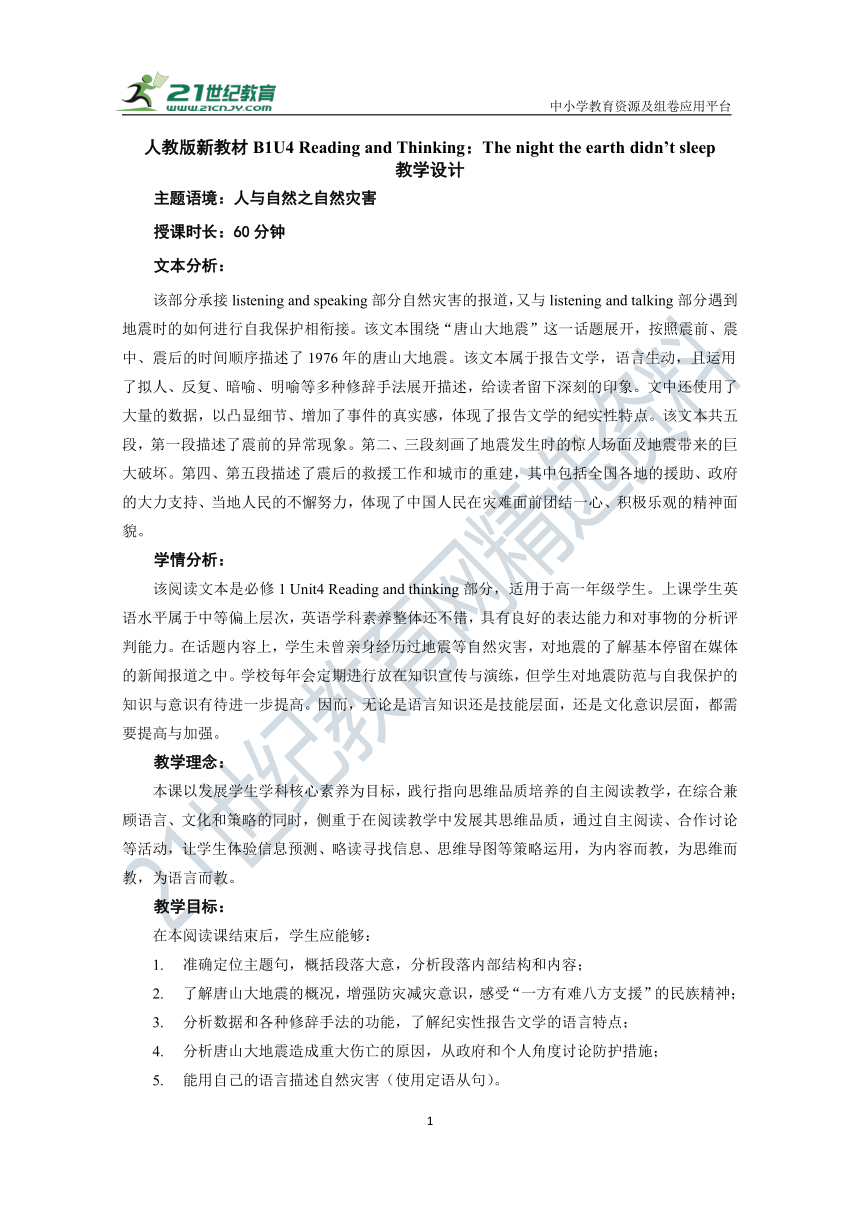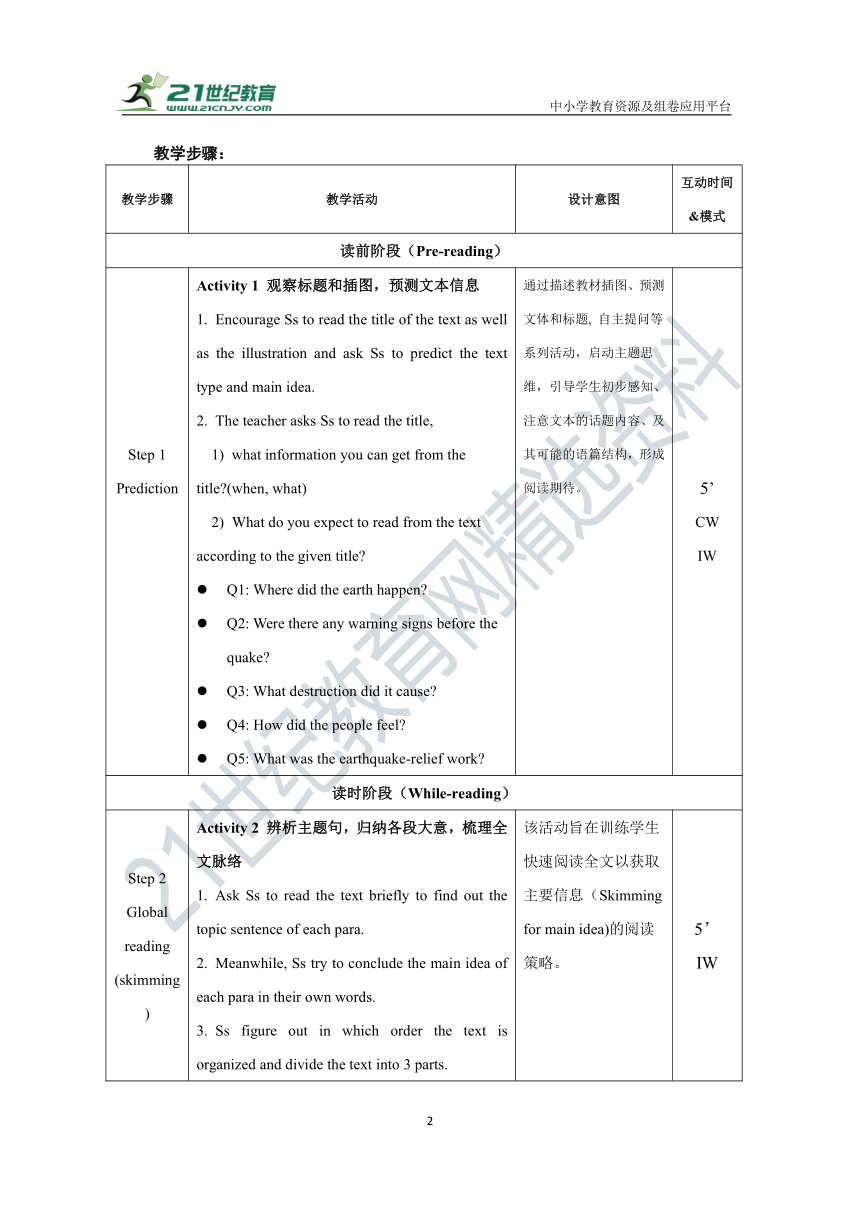人教版(2019)必修第一册 Unit 4 Natural disasters Readingand Thinking 教案
文档属性
| 名称 | 人教版(2019)必修第一册 Unit 4 Natural disasters Readingand Thinking 教案 |

|
|
| 格式 | docx | ||
| 文件大小 | 1.3MB | ||
| 资源类型 | 试卷 | ||
| 版本资源 | 人教版(2019) | ||
| 科目 | 英语 | ||
| 更新时间 | 2024-09-22 09:13:33 | ||
图片预览


文档简介
中小学教育资源及组卷应用平台
人教版新教材B1U4 Reading and Thinking:The night the earth didn’t sleep
教学设计
主题语境:人与自然之自然灾害
授课时长:60分钟
文本分析:
该部分承接listening and speaking部分自然灾害的报道,又与listening and talking部分遇到地震时的如何进行自我保护相衔接。该文本围绕“唐山大地震”这一话题展开,按照震前、震中、震后的时间顺序描述了1976年的唐山大地震。该文本属于报告文学,语言生动,且运用了拟人、反复、暗喻、明喻等多种修辞手法展开描述,给读者留下深刻的印象。文中还使用了大量的数据,以凸显细节、增加了事件的真实感,体现了报告文学的纪实性特点。该文本共五段,第一段描述了震前的异常现象。第二、三段刻画了地震发生时的惊人场面及地震带来的巨大破坏。第四、第五段描述了震后的救援工作和城市的重建,其中包括全国各地的援助、政府的大力支持、当地人民的不懈努力,体现了中国人民在灾难面前团结一心、积极乐观的精神面貌。
学情分析:
该阅读文本是必修1 Unit4 Reading and thinking部分,适用于高一年级学生。上课学生英语水平属于中等偏上层次,英语学科素养整体还不错,具有良好的表达能力和对事物的分析评判能力。在话题内容上,学生未曾亲身经历过地震等自然灾害,对地震的了解基本停留在媒体的新闻报道之中。学校每年会定期进行放在知识宣传与演练,但学生对地震防范与自我保护的知识与意识有待进一步提高。因而,无论是语言知识还是技能层面,还是文化意识层面,都需要提高与加强。
教学理念:
本课以发展学生学科核心素养为目标,践行指向思维品质培养的自主阅读教学,在综合兼顾语言、文化和策略的同时,侧重于在阅读教学中发展其思维品质,通过自主阅读、合作讨论等活动,让学生体验信息预测、略读寻找信息、思维导图等策略运用,为内容而教,为思维而教,为语言而教。
教学目标:
在本阅读课结束后,学生应能够:
准确定位主题句,概括段落大意,分析段落内部结构和内容;
了解唐山大地震的概况,增强防灾减灾意识,感受“一方有难八方支援”的民族精神;
分析数据和各种修辞手法的功能,了解纪实性报告文学的语言特点;
分析唐山大地震造成重大伤亡的原因,从政府和个人角度讨论防护措施;
能用自己的语言描述自然灾害(使用定语从句)。
教学步骤:
教学步骤 教学活动 设计意图 互动时间&模式
读前阶段(Pre-reading)
Step 1 Prediction Activity 1 观察标题和插图,预测文本信息 Encourage Ss to read the title of the text as well as the illustration and ask Ss to predict the text type and main idea. The teacher asks Ss to read the title, what information you can get from the title (when, what) What do you expect to read from the text according to the given title Q1: Where did the earth happen Q2: Were there any warning signs before the quake Q3: What destruction did it cause Q4: How did the people feel Q5: What was the earthquake-relief work 通过描述教材插图、预测文体和标题, 自主提问等系列活动,启动主题思维,引导学生初步感知、注意文本的话题内容、及其可能的语篇结构,形成阅读期待。 5’ CW IW
读时阶段(While-reading)
Step 2 Global reading (skimming) Activity 2 辨析主题句,归纳各段大意,梳理全文脉络 Ask Ss to read the text briefly to find out the topic sentence of each para. Meanwhile, Ss try to conclude the main idea of each para in their own words. Ss figure out in which order the text is organized and divide the text into 3 parts. 该活动旨在训练学生快速阅读全文以获取主要信息(Skimming for main idea)的阅读策略。 5’ IW
Step 3 Detailed reading Activity3: 利用思维导图,深层解读文本内容和写作手法,提升思维品质 Students think about the following questions to have a deeper understanding of the first para and the writing technique the writer uses. Guiding questions (para 1): ①The signs before the earthquake can be classified into 3 aspects, what are they (peculiar animal behaviors ; hints from facilities; strange natural phenomena) ②What writing techniques did the author employ to illustrate the warning signs and what is the function of these writing techniques ③What was the response of the local people to these signs Why did they respond in this way [lack of knowledge of earthquake warning signs; the time the earthquake hit] ④What did the response of local people imply Read paragraphs 2-3 and analyze in which aspects the author illustrates the destruction of the quake and the writing methods. Guiding questions: ①In which aspects did the author illustrate the damage and destruction during the quake ②What writing techniques did the author use and what can be reflected by all these techniques ( how powerful and deadly the earthquake was) ③What were people’s feelings at that time 学生在问题链的引导下,对文本信息进行深层次的解读。学生对震前征兆进行归类,分析当地人民对地震来临一无所知的原因,既增长了警惕地震的相关知识,又训练了归类、推理、判断、分析等逻辑性与批判性思维能力。 同时学生掌握了通过五感写作,重复,对比使描写更加生动形象的写作方法。 学生通过分析修辞手法及其作用,进一步了解修辞可以增强语言感染力和文本可读性的优势;此外,学生掌握了用具体数据客观精确反应事实,增强事实可信度与说服力的写作方法。并结合语境,体会了灾区人民绝望,无助的心情,从而过渡到下一部分。 30’ IW GW CW
3: Read paragraphs 4-5 and analyze the rescue and revival work after the quake. Why does the writer say “hope was not lost” What exactly was the rescue work What did the relief work demonstrate ③ What was the city like at that time How did the author illustrate it ④How did the author organize para 5 ⑤What contributes to successful revival of the city 活动训练学生通过查读寻找主题句,进行概括的能力(主题句——原因——结果——结论),引导学生思考反复、比喻、拟人等修辞手法的作用以及应用数据的功能,学会分析段内关系,树立“灾难无情,人有情”的理念。
Activity 4:分析文本类型和标题 Based on the title, illustration, content and language of the text, students analyze the genre of the text. What is the text type of the passage Discuss in groups from the following aspects. (title, illustration, content and language) Do you think it a good title and why 学生在深入学习文本的基础上回归到文本类型,从形式,内容,语言上分析了不同文本所具有的特点; 同时评价标题特点,总结标题应具有的一般特征,锻炼了批判性思维能力,拓展了思维的广度和深度。 5’ IW GW CW
读后阶段(Post-reading)
Step 4 critical thinking Activity 5 剖析原因,寻找问题根源; 联系实际,提升防震减灾意识 Students work in groups and discuss every possible reason why the Tangshan earthquake brought about such destructive consequences and what precautionary measures government and individuals could take to cope with it. Guiding questions: 1. Why did the Tangshan earthquake cause such heavy loss of lives 2. What shall we do to reduce the loss of lives before earthquakes and during earthquakes? 通过深入探讨地震造成严重破坏的各层原因,如人类的主观认识和行为,以及地震的强度等客观原因,进一步锻炼了学生的批判性思维。 学生结合生活实际,从政府和个人两个角度,思考在地震前和地震中应采取的措施,减少人员伤亡,提升防震减灾和自我保护意识。 15’ IW PW CW
Step 6 Homework Ask Ss to write a blog about the earthquake they experienced suppose they were survivor of the earthquake: T: Suppose you were survivor of the quake, write your story down, and share it on your blog. Try to use what we’ve learned in class. 基于所创设情境,依托建构创造类读后活动,迁移、运用主题内容及语言,建构新语篇。
备注:Ss: Students IW: Individual work GW: Group work CW: Class work
板书设计:
The night the earth didn’t sleep
7
人教版新教材B1U4 Reading and Thinking:The night the earth didn’t sleep
教学设计
主题语境:人与自然之自然灾害
授课时长:60分钟
文本分析:
该部分承接listening and speaking部分自然灾害的报道,又与listening and talking部分遇到地震时的如何进行自我保护相衔接。该文本围绕“唐山大地震”这一话题展开,按照震前、震中、震后的时间顺序描述了1976年的唐山大地震。该文本属于报告文学,语言生动,且运用了拟人、反复、暗喻、明喻等多种修辞手法展开描述,给读者留下深刻的印象。文中还使用了大量的数据,以凸显细节、增加了事件的真实感,体现了报告文学的纪实性特点。该文本共五段,第一段描述了震前的异常现象。第二、三段刻画了地震发生时的惊人场面及地震带来的巨大破坏。第四、第五段描述了震后的救援工作和城市的重建,其中包括全国各地的援助、政府的大力支持、当地人民的不懈努力,体现了中国人民在灾难面前团结一心、积极乐观的精神面貌。
学情分析:
该阅读文本是必修1 Unit4 Reading and thinking部分,适用于高一年级学生。上课学生英语水平属于中等偏上层次,英语学科素养整体还不错,具有良好的表达能力和对事物的分析评判能力。在话题内容上,学生未曾亲身经历过地震等自然灾害,对地震的了解基本停留在媒体的新闻报道之中。学校每年会定期进行放在知识宣传与演练,但学生对地震防范与自我保护的知识与意识有待进一步提高。因而,无论是语言知识还是技能层面,还是文化意识层面,都需要提高与加强。
教学理念:
本课以发展学生学科核心素养为目标,践行指向思维品质培养的自主阅读教学,在综合兼顾语言、文化和策略的同时,侧重于在阅读教学中发展其思维品质,通过自主阅读、合作讨论等活动,让学生体验信息预测、略读寻找信息、思维导图等策略运用,为内容而教,为思维而教,为语言而教。
教学目标:
在本阅读课结束后,学生应能够:
准确定位主题句,概括段落大意,分析段落内部结构和内容;
了解唐山大地震的概况,增强防灾减灾意识,感受“一方有难八方支援”的民族精神;
分析数据和各种修辞手法的功能,了解纪实性报告文学的语言特点;
分析唐山大地震造成重大伤亡的原因,从政府和个人角度讨论防护措施;
能用自己的语言描述自然灾害(使用定语从句)。
教学步骤:
教学步骤 教学活动 设计意图 互动时间&模式
读前阶段(Pre-reading)
Step 1 Prediction Activity 1 观察标题和插图,预测文本信息 Encourage Ss to read the title of the text as well as the illustration and ask Ss to predict the text type and main idea. The teacher asks Ss to read the title, what information you can get from the title (when, what) What do you expect to read from the text according to the given title Q1: Where did the earth happen Q2: Were there any warning signs before the quake Q3: What destruction did it cause Q4: How did the people feel Q5: What was the earthquake-relief work 通过描述教材插图、预测文体和标题, 自主提问等系列活动,启动主题思维,引导学生初步感知、注意文本的话题内容、及其可能的语篇结构,形成阅读期待。 5’ CW IW
读时阶段(While-reading)
Step 2 Global reading (skimming) Activity 2 辨析主题句,归纳各段大意,梳理全文脉络 Ask Ss to read the text briefly to find out the topic sentence of each para. Meanwhile, Ss try to conclude the main idea of each para in their own words. Ss figure out in which order the text is organized and divide the text into 3 parts. 该活动旨在训练学生快速阅读全文以获取主要信息(Skimming for main idea)的阅读策略。 5’ IW
Step 3 Detailed reading Activity3: 利用思维导图,深层解读文本内容和写作手法,提升思维品质 Students think about the following questions to have a deeper understanding of the first para and the writing technique the writer uses. Guiding questions (para 1): ①The signs before the earthquake can be classified into 3 aspects, what are they (peculiar animal behaviors ; hints from facilities; strange natural phenomena) ②What writing techniques did the author employ to illustrate the warning signs and what is the function of these writing techniques ③What was the response of the local people to these signs Why did they respond in this way [lack of knowledge of earthquake warning signs; the time the earthquake hit] ④What did the response of local people imply Read paragraphs 2-3 and analyze in which aspects the author illustrates the destruction of the quake and the writing methods. Guiding questions: ①In which aspects did the author illustrate the damage and destruction during the quake ②What writing techniques did the author use and what can be reflected by all these techniques ( how powerful and deadly the earthquake was) ③What were people’s feelings at that time 学生在问题链的引导下,对文本信息进行深层次的解读。学生对震前征兆进行归类,分析当地人民对地震来临一无所知的原因,既增长了警惕地震的相关知识,又训练了归类、推理、判断、分析等逻辑性与批判性思维能力。 同时学生掌握了通过五感写作,重复,对比使描写更加生动形象的写作方法。 学生通过分析修辞手法及其作用,进一步了解修辞可以增强语言感染力和文本可读性的优势;此外,学生掌握了用具体数据客观精确反应事实,增强事实可信度与说服力的写作方法。并结合语境,体会了灾区人民绝望,无助的心情,从而过渡到下一部分。 30’ IW GW CW
3: Read paragraphs 4-5 and analyze the rescue and revival work after the quake. Why does the writer say “hope was not lost” What exactly was the rescue work What did the relief work demonstrate ③ What was the city like at that time How did the author illustrate it ④How did the author organize para 5 ⑤What contributes to successful revival of the city 活动训练学生通过查读寻找主题句,进行概括的能力(主题句——原因——结果——结论),引导学生思考反复、比喻、拟人等修辞手法的作用以及应用数据的功能,学会分析段内关系,树立“灾难无情,人有情”的理念。
Activity 4:分析文本类型和标题 Based on the title, illustration, content and language of the text, students analyze the genre of the text. What is the text type of the passage Discuss in groups from the following aspects. (title, illustration, content and language) Do you think it a good title and why 学生在深入学习文本的基础上回归到文本类型,从形式,内容,语言上分析了不同文本所具有的特点; 同时评价标题特点,总结标题应具有的一般特征,锻炼了批判性思维能力,拓展了思维的广度和深度。 5’ IW GW CW
读后阶段(Post-reading)
Step 4 critical thinking Activity 5 剖析原因,寻找问题根源; 联系实际,提升防震减灾意识 Students work in groups and discuss every possible reason why the Tangshan earthquake brought about such destructive consequences and what precautionary measures government and individuals could take to cope with it. Guiding questions: 1. Why did the Tangshan earthquake cause such heavy loss of lives 2. What shall we do to reduce the loss of lives before earthquakes and during earthquakes? 通过深入探讨地震造成严重破坏的各层原因,如人类的主观认识和行为,以及地震的强度等客观原因,进一步锻炼了学生的批判性思维。 学生结合生活实际,从政府和个人两个角度,思考在地震前和地震中应采取的措施,减少人员伤亡,提升防震减灾和自我保护意识。 15’ IW PW CW
Step 6 Homework Ask Ss to write a blog about the earthquake they experienced suppose they were survivor of the earthquake: T: Suppose you were survivor of the quake, write your story down, and share it on your blog. Try to use what we’ve learned in class. 基于所创设情境,依托建构创造类读后活动,迁移、运用主题内容及语言,建构新语篇。
备注:Ss: Students IW: Individual work GW: Group work CW: Class work
板书设计:
The night the earth didn’t sleep
7
